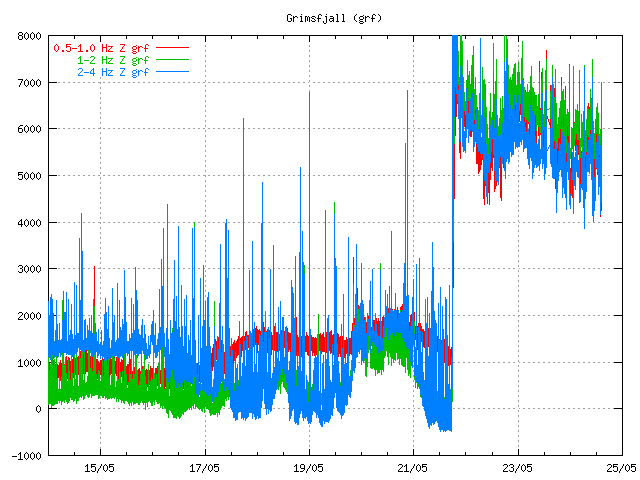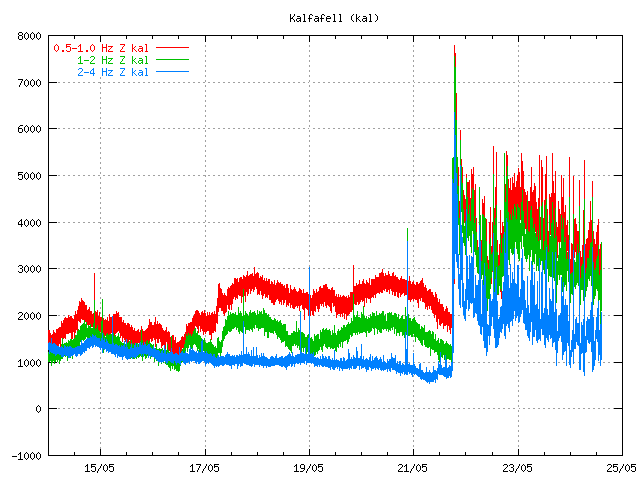It has been reported in the news that the eruption in Grímsfjall volcano (also known as Grímsvötn) is getting less powerful as the time passes. This is perfectly normal for an eruption in Grímsfjall volcano.
This can also be seen on tremor plots around Grímsfjall volcano. They clearly show the eruption getting less powerful over time. It has also been reported in the news that the material that is being erupted is now estimated to be 100 tons/second at the moment. But just yesterday it was 1000 tons/second and up to 2000 tons/second. The eruption is currently stable, even if it smaller then it was in the first few days. It is also not certain if this eruption is going to turn into lava eruption. As there seems to be enough water to continue ash phase of the eruption for the next few days.
Grímsfjall SIL station. It clearly shows the eruption getting less powerful over time.
Kálfafell SIL station. It shows the same pattern as Grímsfjall SIL station. Copyright of both pictures belongs to Icelandic Met Office.
In the news it has also been suggested that there might be less or no influx of new magma from great depth. But I do not know for sure if that is just speculation or not.
The ash plume has only got up to 3 to 5 km according to news reports. This means that has dropped a good distance in the last 24 hours. But yesterday it did reach up to 5 to 9 km. So ash is not spreading far away as it did earlier in this eruption. What is creating flight disruption in Europe and over Iceland is the volcano ash that was ejected in the first few days of the eruption. It has also been an big problem in Iceland is the volcano ash that is getting air blown on the ground. The ground is dry so the volcano ash moves easily because of that. Update 1: It has also been reported that the ash that did was ejected on the first day of Grímsvötn eruption was like all the ash ejected in the Eyjafjallajökull volcano eruption in the year 2010. They also say that this eruption was about the size of normal Katla eruption in there own estimate. News about this can be found here (Icelandic, picture)
Scientists did go today up to Vatnajökull glacier in an attempt to get close the eruption site. Flight over the Grísmfjall volcano is also taking place in an attempt to see the eruption site and take measurements of the eruption.
Update 2: There has been an minor spike in the tremor plot in the last hour or so. I do not know why that is. But this suggest that the eruption is growing in power again.
Icelandic News about it. Use Google Translate if you want some funny reporting.
Dregur úr gosvirkni (Rúv.is, Icelandic)
Dregið hefur úr eldsgosinu – umtalsvert minni gosefnaframleiðsla (Vísir.is, Icelandic)
Dregur úr gjóskuframleiðslu (mbl.is, Icelandic)
Please note that information here might get outdated really fast and with no warning at all!
Post updated at 17:57 UTC.



Jón:
I take the chance to thank you once more for the tireless effort to keep us updated with the current news, and to congratulate you for the excellency of your work.
Yes Thanks Jon. I hope this will not make it really hard for you to get back to Iceland as you planned?
Only if there are flight delays. Everything else is finished here in Denmark in regards to the move.
What is left is going to be finished in this week by me. But it is not a lot as the main stuff when moving is done (that is shipping my stuff to Iceland).
Here is news in english about this eruption.
http://volcano.visir.is/
http://www.space.com/11749-grimsvotn-volcano-eruption-satellite-photos.html
It’s my imagination or i see a fissure in the ground in grimsvotn webcam?
Luisport can you please give me a link to this webcam
http://live.mila.is/grimsvotn2/
But all i see is ash in the air. No fissure as far as I can see. Where on the screen did you see that luisport?
In the groud, between the two rocks… sometimes is biger and sometimes it seams it closes… strange!
I think that is just poor resolution on the webcam. If a fissure would open due to volcanic activity there would be a lava fountain spewing. No ash since the ground is not covered in ice and because of that no explosive activity (water/magma interaction)
Professor Magnús Tumi Guðmundsson, geophysicist at the University of Iceland told members of the press that the eruption in Grímsvötn is practically over, during debriefing by the Department of Civil Protection a few minutes ago. According to Guðmundsson, the eruption now amounts to a small eruption typical of the volcano Hekla. The volume is very low, and the ash would likely only disperse in the area closest to the volcano, in the Vatnajökull glacier.
http://www.facebook.com/notes/inspired-by-iceland/eruption-report-everything-we-now-know-about-the-eruption-in-one-place/205192462831713
Well if its over, where is that tremor coming from?
The ash plume has fallen off dramatically, the inflation has fallen back to its 2004 level – yet the tremor appears to be almost unaffected ( after the intial peak).
We dont actually know that the tremor is now coming from Grimsvotn – it is impossible to triangulate. Could it be coming from a nearby structure, and been triggered by Grimsvotn erupting. In other words are there two components to the tremor: that from Grims itself, including the peak. And now tremor from elsewhere nearby. I’d be looking at Hammarin-Loki-Gjalp, where there has been more EQs and at greater deth over the past 20 years that under Grimsvotn.
My Icelandic is not that good (whether Google is any better is another question), but I’ve just read an interesting page on RUV where geologists comment that Grímsvötn has an activity cycle of around 130 years :
Tíð gos í Grímsvötnum næstu áratugi
After a period of quiescence – no eruptions between 1938 and 1983 for example – it is suggested that we are now at the start of an active phase, which will peak mid-century.
Re the webcam I saw a red glow there early this morning, but I assumed that it was just sunrise.
The webcam seems to be shuddering – is that wind?
What is the earthquaking which is starting south of Grimsvotn? Could that be where the tremor is coming from?
Oddly, as I’m writing tremor activity appears to have reached its lowest since the eruption onset.
But it is not dropping at the same rate as the plume at all.
Or could the tremor be related to ice melt? In which case it could go on for a long time after eruption.
Perhpas we have a subglacial eruption too?
Any ideas anyone?
Yes tremor is down suddenly at Grimsvotn and all sites around the ice cap. So not instrument fault.
Wind dropped? – have we been tricked into thinking the tremor was geological not aerial? – Jon?
Drop in the tremors, earthquakes almost no, it seems that reaches its end, at least is what I believe.
It looks like the tremors may be gradually dropping, but I think the sudden drop was just a spike and went up again, probably to drop more gradually now.
Seems the ash from the main eruption decided to touch down in western norway today. There’s a lingering burnt smelling quality to the air outside even though it’s raining, and the air quality here in Bergen was really poor today with a warning for everyone with a respatory disability to stay indoors.
Have the exact coordinates of the eruption site been determined?
The scale of the met office web tremor plot is logarithmic: http://hraun.vedur.is/ja/oroi/grf.gif , even tho the numbers on the left side look linear.
The scale of the working tremor plot is linear: http://www.vedur.is/media/jar/medium/grf_trem.gif
These plots are from the same data but look different.
hi
earthqukes are showing up at grimsfjall again. three so far depth 4.7km, 1.1km and 4.3km.
it could mean new magma’s is moving up from the magma chamber to renew this eruption or start one near by. I could be wrong
One of the EQ has a lower quality. The majority of the high quality quakes seem to be SSE of the volcano and be of low depth. Are these perhaps icequakes due to thermal stress on the glacier from the meltwater?
The tremors seems to have stabilized with the same downward trend as we’ve seen for the last two days.
This are not icequakes far as I can tell. This are real earthquakes in the crust.
Miðvikudagur
25.05.2011 04:56:11 64,288 -17,049 8,1 km 1,5 90,01 16,9 km SA af Grímsfjalli
Deep quakes are also taking place .
Yes, you are right. That last one was definitively not an icequake.
Also, the tremors have been fluctuating quite a lot for the last hours. Between 7000 nm/s for the middle hz and as low as 1000 nm/s for the high hz. Don’t know what that means, besides that it’s quite hard to read it. It’s still harmonic though.
Tremors are dying down really fast now. Its closing to the levels prior to the eruption. Maybe due to the violent start of it most of the trapped magma was ejected in one shot?
I think the eruption might be over for this time. Lets see if anything else happens or if we are facing yet another quiet period.
http://hraun.vedur.is/ja/oroi/grf.gif
Another (poor quality) quake on the SE part of Grimsfjall. I can´t seem to remember if I have ever seen quakes in this particular area before. Maybe we will se a new fissure eruption here?
It would actually make sense. The eruption was very violent and resulted in a plinian/subplinian (not sure about that though) eruptive column. And then it died down really fast but the tremors was still going strong.
My first thought would be that magma has found an alternative route towards the surface. Maybe in this SSE area?
And now the tremors are going down really fast.
And bear with me here because I have a theory about that too. 🙂
Think of a garden hose. Run water through it and let it out on the other end. If you hold the hose in your hand you feel the water rushing through kinda like vibration in the hose.
Now if you plug the open end and stop it from releasing the water will still flow in there but increase in pressure. But the vibration in the hose will be alot smaller due to this pressure.
Thoughts about this?
Guess the tremor could also be dropping since there are almost no explosions any more in the crater caused by the contact of magma with water..? Therefore it is still possible that magma is on the move without a high amount of tremors..? ==> which suits your theory of the garden hose 😛
New blog post is up.
those later quakes could possibly also be related to the contraction of the magma chamber complex, if it emties – the pressure falls, and the rock above settles down, causing some quakes.